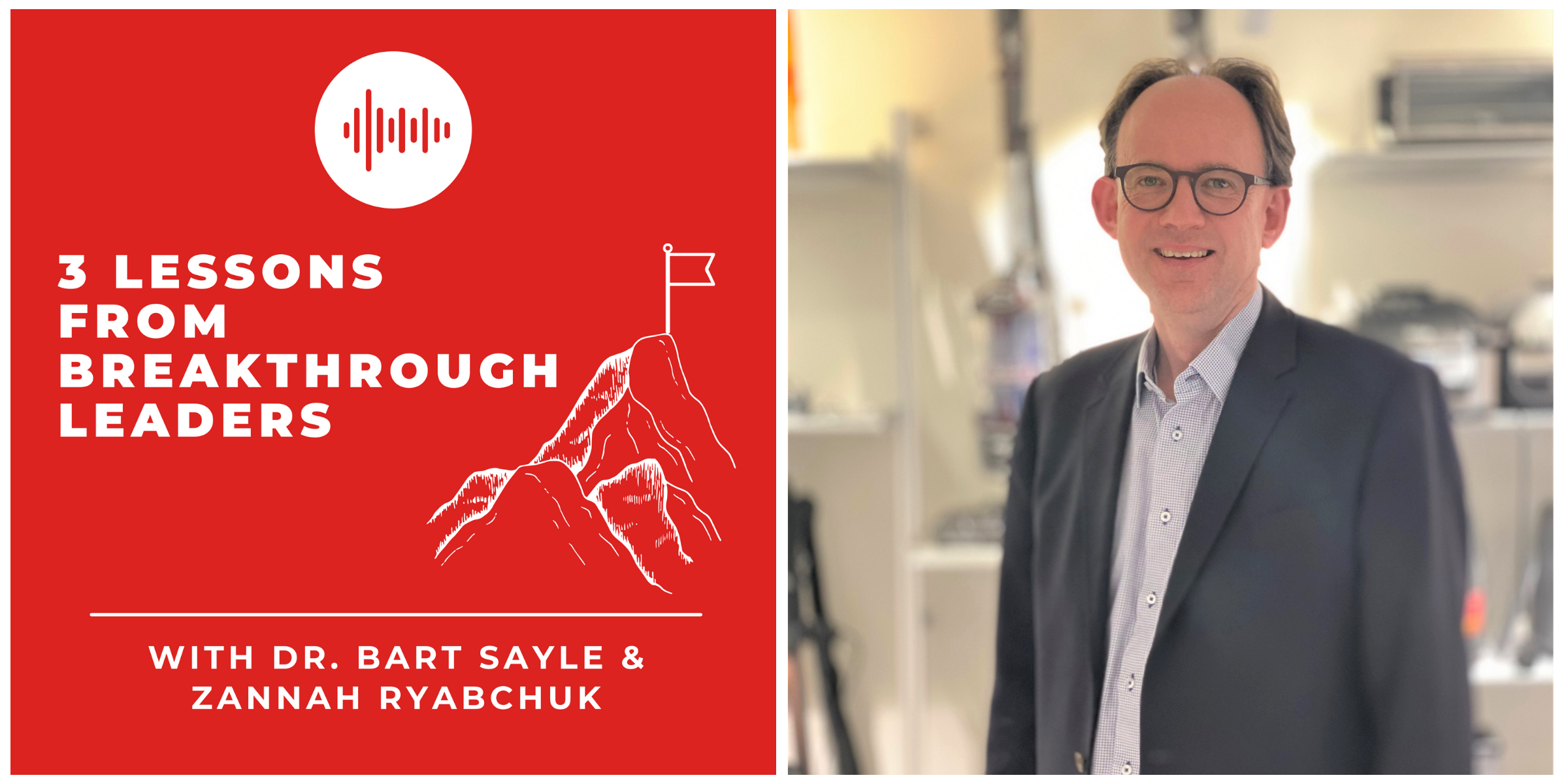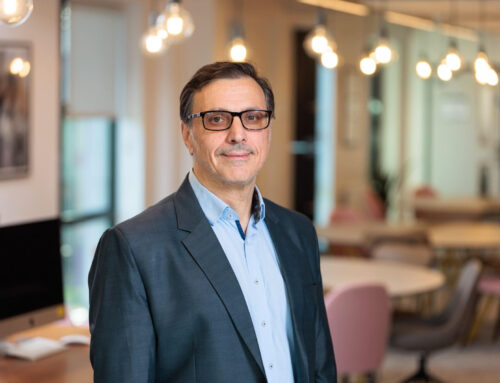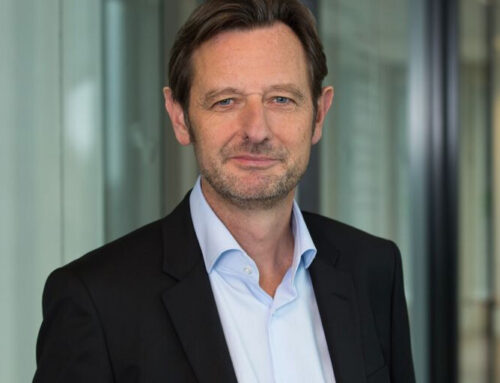 Welcome to our sixth podcast episode!
Welcome to our sixth podcast episode!
Do you want to learn what it takes to maintain an innovative business?
Listen to our latest podcast episode on Mindset and Innovation with Dr Tim Moore!
Tim is Executive Vice President Shark Robotics at SharkNinja and previously as VP Innovation and CTO for ghd, Tim led and built their world-class laboratory facilities.
You can find Tim’s LinkedIn profile here.
Listen to the S1 E6 ‘Mindset for Innovation’ with Tim

 .
.
In this episode, we will learn these 3 lessons from Tim
- Innovate, or fade away
- Hold your success close, your failure closer
- Why momentum matters
This podcast was recorded in the summer of 2021.
If you enjoyed this episode, make sure you subscribe to this podcast and please do leave us a review and rating on your player of choice. We will be updating you on upcoming episodes on our social media so remember to follow us.
Transcript of the episode
Zannah Ryabchuk
Hello, and welcome back to 3 Lessons from Breakthrough Leaders. I’m Zannah Ryabchuk, MD at Breakthrough Global.
Dr. Bart Sayle
And I’m Dr. Bart Sayle Breakthrough CEO and founder, we’ve spent 30 years developing the Breakthrough Methodology to transform companies who want to reach their highest level.
Zannah Ryabchuk
And in this podcast, we’ll get to the heart of that transformation, meeting leaders and creative talents to share three lessons that we guarantee will help you and your companies to unleash your potential. And Bart and I will take a moment to analyse the key takeaways and opportunities for breakthrough thinking.
Dr. Bart Sayle
In today’s episode, we’ll learn from a true pioneer in consumer innovation. Dr. Tim Moore. Tim is executive Vice President Shark Robotics at SharkNinja and previously, as VP Innovation and CTO for ghd, Tim led and built their world class laboratory facilities.
Zannah Ryabchuk
And today, we’ll hear these three lessons from Tim, innovate or fade away.
Dr Tim Moore
You as a business, serve your customers in the aristocratic world, they forget that and they start thinking that we know best, we know what you want. And you can sort of see some of the companies that have gone up to being aristocratic you know, the classic ones always use people like Kodak and look what’s happened to them now.
Zannah Ryabchuk
Hold your success close your failure closer.
Dr Tim Moore
I think what breakthrough did for me was suddenly in the way that you kind of think about your mindset, that was the moment, for me, it was the aha moment.
Zannah Ryabchuk
Why momentum matters.
Dr Tim Moore
Actually, if you sit back, take a moment, think it through, follow a bit of process doesn’t mean that that issue will get fixed in the next two hours. But it’s now you’ve had more chance to really think about it. And that’s almost you know, it’s like, you know, Hitchhiker’s Guide to the Galaxy, big friendly letters, don’t panic, you know. It is that kind of mantra, you need in the crisis environment, it’s, it’s like stand back, the wheels will not fall off, because you’ve got momentum.
Dr. Bart Sayle
Lesson one, barbarians and bureaucrat. Innovation, to me, is what I call a fat word, something that has so many different meanings. If you were to Google innovation, I don’t know how many hits you would get, it’s going to be in the millions. So I’d like to start off with your view of or your definition of what innovation is, and particularly commercial innovation.
Dr Tim Moore
For me innovation is literally doing something which hasn’t been done before. And that could be a product, it could be a technology, it could be a business method, or it could be a combination of these things. It could be combining aspects of one other industry, another business model, etc, to create something new and innovative. So for me purely, innovation has to be something literally, you know, the world hasn’t seen or or experienced before. You know, and I take that kind of definition, from the days of when I was doing my PhD, where in order to pass your PhD, you had to, you had to actually discover something that the world had not seen before. You know, there are different types of innovation. So the way we think of things here and in the past is subdividing that innovation into sort of kind of like three categories. One is what we call news. So it’s more basic innovation, as it were. So it might be something when we say it’s new to the market, it might be something like a change of the inner product world, it might be a new design or shapes, it might not be something sort of like earth shattering, that sort of challenges, the laws of physics. Then we have new and new is what we would call you’re adding technologies together to create something new. And then you have breakthrough, which is the ones where you you really are, you know, you’re challenging the laws of the universe, it’s a completely new way of doing things a completely new business model, it might be a completely new technology that you’re feeding into, into a product.
Dr. Bart Sayle
That’s great. And that’s that’s a really good set of distinctions that people can work with. You’ve been in this field for some time now. How has it changed the area of commerce and innovation.
Dr Tim Moore
It’s a lot lot faster than it used to be. You know, when I when I first started out the internet was just beginning. If you didn’t know what you wanted, then you wanted to know the information quickly you might have to use the fax machine or what was known as a bulletin board over the computer so so and if they didn’t have the information then you literally had to wait two days for it to turn up in the post to get the datasheet, so design and development was was a lot slower. Today all of that information is instantaneously available. There is also a lot more componentization, particularly in electronics, so you don’t have to design and build down to scratch, you can actually just build on the building blocks have already been created. And that means that again, you can go much faster. But you can also develop things very, very complex things on much, much tighter budgets than used to do in the past.
Dr. Bart Sayle
So Tim, what for you makes a company innovative, versus a company that isn’t as innovative or isn’t innovative at all ?
Dr Tim Moore
For me, it’s the leadership, which then distills right the way through the organisation. So it all, it always feedsback to mindset for me. And the way that provides right the way through the organisation, and I’ve experienced, what happens to organisations because, you know, typically, I tend to stay at companies for like, you know, 10 year batches. So in that time, you tend to experience a variety of, particularly the private equity world where you where your business is owned by the private equity, you tend to experience a change of CEOs, whatever. So you kind of like experience what happens, one of the things that really helped me and understanding what was going on is some of the stuff that Lawrence Miller did, on sort of barbarians to bureaucrats. So this idea that you can sort of think of, you know, the lifecycle of a business, as going from, you know, profit at the startup where you have, you know, the visionary person there who’s just, you know, all about driving as the visionary leader, perhaps not, maybe not the greatest delivery, but you know, very much in the magical thinking world, then as the company develops, you move into the barbaric, barbarian phase where you haven’t got the processes, things are all a bit crazy, but you’re growing like stink, everything’s all about crisis management, you know, and it’s the, it’s the point of time of the hero manager, or the hero developer, who takes everything and then gradually, as you move out of that, you move into the builder explorer phase, where maturity starts to set in, I start thinking the companies begining to act more like a 20 year old, rather than a recalcitrant teenager. And at that point, you start, you know, building the business or building capabilities. So you know, in a product business, that means getting better and better Productionisation, the processes that lead up to it, the processes of innovation themselves. And then explorer it when you’re going out. And you’re building new markets your expanding out literally, you know, thinking Magallon, and all that, you know, you’re moving out to different markets. And then then over as you keep going, you become more administrative, so you get better at doing that become a bit more mature, things might start to slow down. And the trick is, once you get up to builder or explore, and you will naturally move over to administrators to then keep that cycle going of battering between the two. Because otherwise, if you carry on going on administrator, you become bureaucratic. And you start believing that you’re the best in the world, and nobody else knows what they’re talking about, and ultimately you become aristocratic, which is where you you forget, actually, you as a business, serve your customers, you know, in the consumer world. At the end of the day, we are consuming, consuming, consuming consumer, what they think and then in the aristocratic world they forget that and they start thinking actually, we know best, we know what you want. Here it is. And you can sort of see some of the companies that have gone up to being asked to aristocratic you know, the classic ones always use people like Kodak and stuff like that. And look what’s happened to them now.
Zannah Ryabchuk
It was fascinating to hear Tim talk about leadership and the mindset of leadership and how absolutely critical that is to successful innovation. And I find that whole concept and journey of the idea of barbarians to bureaucrats just so fascinating as well.
Dr. Bart Sayle
Me too. I like the example with Kodak as well. It’s a classic example. But it’s very illustrative. And in Breakthrough we have the concept of performance ohms and Kodak, which had a high performance culture in its heyday, when gradually roll by roll to a complacent culture and stopped performing. It started looking inward, it no longer innovated. And now where is it yet Kodak was the first company to invent a consumer digital camera.
Zannah Ryabchuk
Incredible. And it’s just so shocking that they’ve completely missed that future. I think it illustrates Tim’s point perfectly. You don’t want to end up as the aristocrats. Okay, on to the next lesson.
Dr. Bart Sayle
Lesson two the innovation mindset.
Zannah Ryabchuk
Do you want to maybe share with our listeners the work that we were doing with you and why it particularly struck a chord what it was about the Breakthrough Mindset that seemed to reignite something in you?
Dr Tim Moore
Breakthrough for me came along at the right time. You know, I was part of an old, really good, very, very strong sort of UK based brand. And gradually, as we grew as an organisation and became more mature as an organisation, it was in that process, we kind of felt like we were beginning to lose some of what made a special as an organisation. And I think what Breakthrough did for me was suddenly in the way that you kind of think about your mindset. That was the moment like, for me, it was the aha moment because I think I was certainly getting gradually more and more cynical. And then what breakthru did with the mindsets of basically thinking through magical thinking. And then heroic action, for me really summed up what it was like in the early days of being in that organisation, and what made it special and great. And indeed, what it’s like here now today, where I’m at the moment in Shark, and it was just the way of just pulling that you just cannot outperform your mindset. And I’d actually got to a point where my mindset was actually impacting my performance. So I’d actually levelled my performance in what I was doing as a manager, as a guy developing products, all of that kind of stuff had actually levelled and dare I say it started going down, I was actually getting worse, I felt myself was going backwards. And suddenly this way of articulating mindset, you can’t outperform your mindset. And then really bringing yourself down having the tools to bring yourself back into magical and heroic, for me was a massive eye opener. Absolutely.
Dr. Bart Sayle
Continuing with this for you. What are the cultural influences or barriers on becoming more innovative as an individual or as a company?
Dr Tim Moore
Fear of failure, I think is number one. And, you know, in consumer products, we have actually very tight and strict timescales. So you’ve got to deliver against them for retail, and all that kind of good stuff. So you cannot play with that. So you have to set up an environment where that will still work. That’s what I call commercial development. The Fast Lane, that’s the the night that literally where failure cannot be supported right. But then you’ve got to have a parallel line, which you call the the technology validation lane, as it were, where you can support failure. And in fact, in many ways, failure was a good thing, particularly if you fail fast, and then don’t repeat. And that’s what you got to set up, I think you got to do that. So there’s a fear of failure, and then putting people in a place where it actually will ultimately fail. So you don’t want to do that. So split it up into development, two things to drive the culture, commercial development, when it’s very, very hard, very operational focus, get stuff done, parallel, track that with the technology validation line, and then set up the systems so that you are in a funnel, what I call a funnel to tunnel approach. So you can have lots of ideas for innovation in there. And ultimately, you know, that that’s going to be whittled down relatively quickly, particularly in the commercial environment, to something which then goes into what I call the tunnel, which is when you deliver tunnel being the commercial development. And then to really get people thinking and joining the dots, it’s a question then of putting in programmes so that you can get, you know, people can try things out. And if it doesn’t work, forget about it, move on, try something else. And they don’t feel feel that they failed. And it’s those kind of tools, I think that can then really shift that that mindset into where you wanted to be, which is both magical and heroic. And those two data stream those two streams I was talking about literally kind of mirror that, you know, you got the magical thinking and the technical validation stream. We call it technical validation, because we don’t wanna make it too magical. Because otherwise it will just go off into the blue skies and never be seen again and what’s the point of that. But you call it technical validation, if you know that there’s got to be an end to what you’re doing. And then you’ve got the product delivery, as it were, which is the commercial stream, and you kind of base the thinking around that. So you then the natural system of the way that you’re operating helps develop the mindset.
Dr. Bart Sayle
Again, going back to my experience,I was in innovation, I was in R&D with a number of companies, including Unilever. And I can remember going back to those times that we had an enormous number of PhDs and graduates and so on. And one of the things I remember from that was that it was very easy to start projects, but it was very difficult to stop.
Dr Tim Moore
And then that’s why I always refer to it as technology validation, because it’s like, it naturally in itself says, there is an end to this, I am valid, I’ve come up with an idea and I’m going to validate it, of course the moment you say technology validation, okay validation against what? And that’s when you can then start driving actually consumer need, what is it that the consumer, you know, wants needs and that’s the other part to the kind of innovation story that I think you have to get right. So obviously explaining about you know about the technical side. The other side that you’ve got in the metric as well is marketing the need want. And one of the things that we do, I’ve done at various companies now is this what I call spark or you could call it whatever you want, where you know, you get every so often every quarter, whatever time you want to do, you literally get all together, the marketers and salespeople and get the techies together in a room and the techies will present ideas and stuff like that, marketing will present you know, this is the market need, this is what we want. And, you know, ideas that, you know, if we could maybe wave a magic wand we might be able to create, you don’t have to be fully technical bait. But then what you’re looking for is that magical crossing point where someone’s got a technology that answers the problem or there is a problem which can be solved with a technology. But what it does is it instils in everybody in the room, something in the back of their mind it plant seeds. So when they go away and do their normal job, somebody in marketing will go oh, I’ ve just come across this, hang on a moment didn’t I see a technology the other day for that. And vice versa, a techie sort of like reading through, you know, Electronics Magazine or whatever, and suddenly sees a new technology and suddenly thinks wouldn’t that be able to answer this market need. And that’s what you’re looking for. And what you tend to find is as you run this process for longer after about a year, you’re getting too much innovation, you know, you’re you’re finally so full, that the problem is now moving to the next stage, which is actually joining all the dots to actually create something really, really good. But yeah, we find that, I find that that kind of spark process that linking together is absolutely key. And it it also helps buying in a product or a concept right from the start right from the birth of it, you know, because marketing, development, etc. were there at the start.
Dr. Bart Sayle
So it’s great to hear Tim, talk about his awareness that it was mindset that was in the way, and that had blocked him. And this is so important for everybody. Because you cannot outperform your mindset. And as far as innovation is concerned, you cannot out innovate your mindset. And if you’re a company, then your culture is the collective mindset. I remember when I was in Unilever, running innovation, one of the insights I had then, which probably wouldn’t be an insight now. But then the insight was that our inability to increase our innovation, our capability of innovation, our capacity for innovation was basically our culture. Our culture was a glass ceiling in our on our ability to innovate. And what we had to do is find a way to break through that glass ceiling. In fact, that was the start of the Breakthrough process, the Breakthrough Methodology, it was breaking through that glass ceiling. And really every company comes up against the glass ceiling at some point when it’s talking about growth and innovation. And it needs to find its ways to break through that glass ceiling. Otherwise, it won’t grow. It won’t innovate.
Zannah Ryabchuk
And I think it’s key that Tim brings into that the idea of needing to fail and having a great culture where failure is expected anticipated and just part of the way that innovation is done. Because you’re not going to grow unless you have a process of trial and error. And you take some measured risks. And we see that this can be a real hindrance to many of our clients when they get stuck in a fear of failure. Right onto Tim’s next lesson.
Dr. Bart Sayle
Lesson three, you’ve always got time.
Zannah Ryabchuk
Tim, I’d like to go back a little bit now and just think about when you were a kid and what got you excited in science.
Dr Tim Moore
What got me excited in science? I think it was just about doing things that are making stuff happen. I mean, it was you know, what did I used to do back then it was sort of like kind of like you know the little petrol engine model aircraft and that kind of you know, I would actually as a kid out of sort of like some crazy ideas I was gonna try and invent things and create things and build things. I think it was just it was like suddenly as I grew up and got older and could suddenly suddenly just finding that you could you know, using wires batteries and various other things you could build stuff like radios or you could you know, control something I guess it was just that power. But something just really attracted me to just sort of you know, the whole science and understanding why could you do it and and be and wow I can actually take this science and I can go and do something really useful with it. And I you know, I’ve always had a passion for products. I’ve always been in consumer electronics products in one way or another.
Zannah Ryabchuk
And what would your advice be to maybe one of our listeners who is just starting out in their R&D career?
Dr Tim Moore
Go for it. Just think magically. And as I say, and when it’s looking like, it’s not gonna work, drop it like hot potato, and go on, but be persistent.
Zannah Ryabchuk
So Tim, thinking about your learnings, can you think back to a really influential leader early in your life, maybe it was in your first career, maybe it was at school, who had a profound impact on you and what it was about their qualities that have stuck with you, in your own leadership.
Dr Tim Moore
I used to do, not anymore, I used to do gliding. And when you when you’re learning to glide, one of the, you know, one of the things you learn is you’ve actually got more time than you think. So if something really catastrophic happens, I remember one time I was being towed up by the tow plane, and I was still learning structures behind me. And the engine stalled on the tapeline. And, you know, the instructor behind me is very, very calm and collected. And he said, right, could you tell me what’s happening? You know, we went through these checks of looking at the instruments looking outside looking at was happening and stuff like that. And eventually, we came to the conclusion that we probably best unhook ourselves from the tapeline. You know, to let the let the guy sort himself out and carry on gliding, which is what we did and staggeringly I still remember it, we unhooked him and I just watched this plane just suddenly, put himself into a dive, so he could restart his propeller, which he did. But the thing was, you know, the instructor said to me at the time, he said, well, what did you learn from that? And I said, well, immediately I should be a lot more observant, you know, and he said yeah, sure. But actually, you’ve got time, you’ve got time to think, no matter how stressful you think the situation is, you have always got time to think. And actually, if you don’t think the situation will be a lot more dangerous for you. And yeah, I’ve carried that through, yeah, even to falling out of like corkscrews stalls and stuff like that, you’ve got time to think, don’t panic. Because sometimes, you know, businesses are in crisis mode, there’s an awful lot going on, you know, there’s lots of crises happening, you take the short term fix to get it, get it done, get the problem fixed off the table on to the next. And that doesn’t necessarily mean that you’ve actually fixed the problem, what it means is you fixed the short term issue, but the actual root cause is still there. But actually, if you sit back, take a moment, think it through, follow a bit of process, it doesn’t mean that that issue will get fixed in the next two hours, it probably means that issue will get fixed in 24 hours or a bit longer. But it’s now you’ve had more chance to really think about it. And that’s almost you know, it’s like, you know, Hitchhiker’s Guide to the Galaxy, the big friendly letters, don’t panic, you know, it is it is that kind of mantra you need in the crisis environment, it’s, it’s like stand back, the wheels will not fall off, because you’ve got momentum. You know, at the end of the day, most of these businesses.
Zannah Ryabchuk
Tim’s lesson that you’ve always got time has actually stuck with me so much over the last few months, it’s really come back to me time and time again, personally and professionally. And that vision of Tim gliding just keeps seeming to reemerge in my consciousness. And I think it’s been particularly prevalent when I’ve been talking with clients, we have so many people who are living their life in the crisis mode at the moment, it’s an absolute struggle for them to break out of this vicious cycle of feeling like they simply do not have time to either resolve the issues that are causing them so much problem, resolve them properly, so that they don’t keep rearing up time and time again, and you know, just kind of plastering over stuff and hoping it will, it will tide them over to the next crisis. But also it’s stopping them from looking at the future and creating the amazing new futures, that are going to help them to succeed for many, many years to come.
Dr. Bart Sayle
That’s so true. Zannah. And thinking about leadership, and for our listeners, if you’re leading a team or leading a group or leading an organisation, as a leader, you’ve always got to have two conversations in your mind. There’s the conversation about now, which can deal with the crises, the urgent, and so on, but there’s another conversation, which is the conversation about the future. And you need to be having both of those conversations constantly. You need to be dealing with the presence and what comes up and what shows up. But you also need to be stretching out and planning the future and planning your bridge to that future.
Zannah Ryabchuk
So now we are going to move on to the Breakthrough Hot Seat questions. Are you ready for the Hot Seat questions, Tim?
Dr Tim Moore
Go for it.
Zannah Ryabchuk
Okay, what’s the most exciting thing you’ve ever done?
Dr Tim Moore
Flying upside down? I was doing a loop and well, two loops actually. It was, at the gliding club I used to go to. There was a wedding on in the sort of like the little hall over the way. And I was still learning at the time and the instructor behind said do you want to show off to a whole load of people? I said, yeah. Okay, fantastic. So we went up to like 2500 feet. And then he said, we’re going to do a loop, he said, you’re gonna fly it and I thought, wow, he said right we’re going to nosedive all the guests. And so we put it put it into those that were flying down and of course, the guy starts screaming. So everybody starts looking up, we can see them all up. That’s when pull back on the stick and fly upside down and do a loop. And it’s absolutely brilliant.
Zannah Ryabchuk
It is making me dizzy just thinking about it. Oh, my goodness. Wow. What inspires you in everyday life?
Dr Tim Moore
Ingenuity of people particularly when something bad happens. We’re gonna need it for climate change that ingenuity, but I’m always impressed by the fact that, that we as human beings, we adapt, we change, we fix stuff. And there’s a whole bunch of us who just do that. So yeah, that inspires me.
Zannah Ryabchuk
And if you could only take one book to a deserted island, what would it be?
Dr Tim Moore
Ah, yeah, so weirdly enough. Actually, I’m dyslexic. So I tend not to read that many books. But when I do I get stuck in them and just read them, like from cover to cover I get really kind of obsessed with it. I don’t know why. But anyway, that’s how it works. But the latest book where, that happened to me, this book made me really at times sweaty, because having been in startups, having sold businesses and stuff like that, there was just times of when I was reading this book, I thought, oh, my God, this is really, really bad. That is Bad Blood Secrets and Lies in a Silicon Valley Startup about Elizabeth Holmes and Theranos. And, you know, this whole culture of fake it until you make it, you know, and for me, this is like magical thinking, but completely unchecked, with no heroic action attached to it whatsoever. And what happens and how they just, you know, I don’t think, you know, there’s all sorts of people saying it’s fraud, but I actually, it didn’t start off like that it actually started off on the solid belief that that you could just will something into being you know, and if and even if the laws of physics didn’t allow it, you could still will it into being and just following that until, until actually, this horrendous end was very unfortunate. And but wow, reading that book, certainly at times, kind of like I couldn’t I couldn’t leave it transfixed by it. Yeah. Great book.
Dr. Bart Sayle
By the way. I love Bad Blood as well. And have you seen the HBO documentary of it? Yes. Oh, my God. Yeah. Because that like puts the real people in there. Thanks so much, Tim. This has been brilliant.
Dr Tim Moore
Thank you very much for listening.
Zannah Ryabchuk
Thank you for joining us for today’s episode, do make sure you hit the subscribe button. And join us next time for another 3 Lessons from Breakthrough Leaders. You can reach out to us at Breakthrough Global on LinkedIn or Facebook via Twitter at Radiant clarity or Instagram at Global Breakthrough.
Dr. Bart Sayle
And we’d love to hear your feedback and your own leadership stories. We’d also love for you to share this episode on your own social media and review and rate this podcast on your player of choice as we want to spread these transformative lessons as wide as possible.
Zannah Ryabchuk
And thanks to our production team Julia Soltysova at Breakthrough Global and Robin Leeburn at Fairly Media, and of course, thank you for listening. See you next time.
Dr. Bart Sayle
Bye.
Transcribed by https://otter.ai





